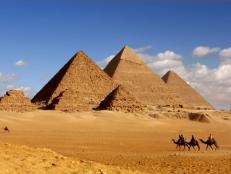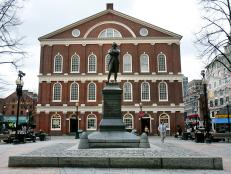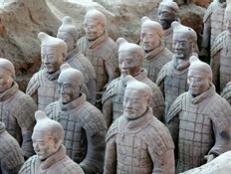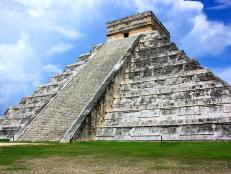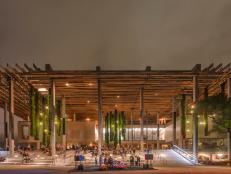Seven Wonders of Egypt
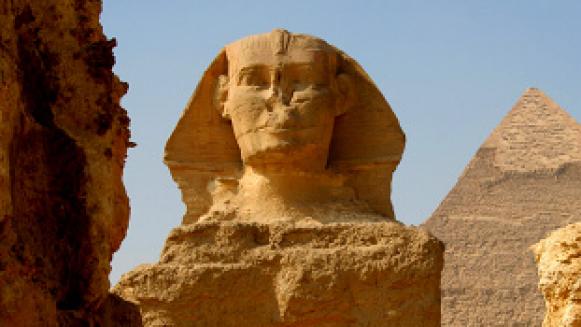
Egypt is famous for its ancient civilization. It's also a top destination for some of the world's most famous sights and monuments. Get the scoop on the seven wonders of Egypt.
Great Pyramid of Giza
Giza, Egypt
The Great Pyramid of Giza is the oldest and largest of the 3 pyramids in the Giza Necropolis bordering Cairo, Egypt. It is the only remaining member of the Seven Wonders of the World and is believed to have been built as a tomb for Fourth Dynasty Egyptian Pharaoh Khufu, constructed over a 20 year period concluding around 2560 BC.
The Great Pyramid is the main part of a complex or set of buildings that include 2 mortuary temples in honor of Khufu. There are also 3 smaller pyramids for Khufu's wives, an even smaller 'satellite' pyramid, a raised pathway connecting the two temples, and small mastaba tombs surrounding the pyramid for nobles. Khufu's vizier, Hemon, or Hemiunu, is believed by some to be the architect of the Great Pyramid.
The Great Sphinx
Giza, Egypt
The Great Sphinx of Giza is a large half-human, half-lion statue in Egypt, on the Giza Plateau at the west bank of the Nile River near Cairo. The commonly used name "Sphinx" was given to it based on the Greek creature with the body of a lion, the head of a woman and the wings of an eagle, though this sphinx have the head of a man. It is one of the largest single-stone statues on Earth, and is commonly believed to have been built by ancient Egyptians in the 3rd millennium BC.
Egyptologists believe the Sphinx represents the likeness of King Khafra, who is also credited as the builder. This would place the time of construction somewhere between 2520 BC and 2494 BC. However, limited evidence supporting this theory has made the idea of who built the Sphinx, and when, the subject of much debate.
After many attempts and over many years, the entire landmark was dug out in 1925. Although most of the Sphinx is intact; the nose on the face is missing. Some people believe the nose was broken off by a cannon ball fired by Napoleon's soldiers, however this has never been proven.
Temple of Luxor
Luxor, Egypt
The Luxor Temple was dedicated to the Theban Triad of Amun-Re, his wife Mut, and his son Khonsu. The large ancient Egyptian temple complex is located on the east bank of the Nile River in the city once known as Thebes, but today it is known as Luxor. Many festivals were celebrated in Thebes and the Temple of Luxor was the center of the most important one, the festival of Opet. Built largely by Amenhotep III and Ramesses II, the temple's purpose appears to have been suitable for the rituals of the festival that sought to reconcile the human aspect of the ruler with the divine office.
For the ancient Egyptians and modern tourists, access to the temple is granted from the north, where a path lined by sphinxes once led all the way to Ipet Sut in modern city of Al-Karnak. A procession of images of the royal family began at Karnak and ended at the temple of Luxor. By the late 18th Dynasty the journey was being made by barge on the Nile River. During the festival the people were allowed to ask favors of the statues of the kings or to the images of the gods that were on the barges.
Cairo
Cairo, Eygpt
Cairo, which means "The Vanquisher or "The Triumphant", is the capital city of Egypt. It has a population of about 15.75 million people, making it the seventh most populous metropolitan area in the world. Old Cairo was founded in 648 AD near other Egyptian cities and villages, including the old Egyptian capital Memphis, Heliopolis, Giza and the Byzantine fortress of Babylon in Egypt. However it was a new city built as a military garrison for Arab troops and was the closest central location to Arabia that was accessible to the Nile.
Today, Greater Cairo encompasses various historic towns and modern districts. A journey through Cairo is a virtual time travel: from the Pyramids, Saladin's Citadel, the Virgin Mary's Tree, the Sphinx, Al-Azhar (the Mosque of Amr ibn al-A'as), Saqqara, the Hanging Church, and the Cairo Tower.
Abu Simbel
Southwest of Aswan, Egypt
Abu Simbel is one of Egypt's Seven Wonders. The archaeological site is comprised of two massive rock temples that were originally carved out of the mountainside during the reign of Pharaoh Ramesses II in the 13th century BC, as a lasting monument to himself and his Queen Nefertari.
The Great Temple at Abu Simbel took about 20 years to build and after its completion, it was dedicated to the gods Amun Ra, Ra Harakhti, and Ptah, as well as the deified Ramesses himself. It is generally considered the grandest and most beautiful of the temples commissioned during the reign of Ramesses II, and one of the most beautiful in Egypt.
Saqqara
South of Cairo, Egypt
Located about 30 km south of Cairo, Saqqara or Sakkara is a vast, ancient burial ground in Egypt, featuring the world's oldest standing step pyramid. While Memphis was the capital of Ancient Egypt; Saqqara served as its cemetery. Although it was eclipsed as the burial ground of royalty by Giza and later by the Valley of the Kings in Thebes; it remained an important place for minor burials and cult ceremonies for more than 3,000 years.
Although the earliest burials of nobles at Saqqara can be traced back to the First Dynasty, it was not until the Second Dynasty that the first kings were buried there, including Hotepsekhemwy and Nynetjer. The step pyramid at Saqqara was designed by Imhotep for King Djoser. It is the oldest complete hewn-stone building known in history and the location of the newly opened Imhotep Museum.
Temple of Karnak
Al-Karnak, Egypt
The temple area is a vast open-air museum and the largest ancient religious site in the world, and is probably the second most visited historical site in Egypt, second only to the Giza Pyramids near Cairo. It consists of 4 main parts, of which only the largest temple is accessible by tourists and the general public. The Precinct of Amon-Re, the largest part of the temple, is the only part most visitors normally see.
There are also a few smaller temples and sanctuaries located outside the enclosing wall of the 4 main parts. The Karnak Temple has several avenues of ram-headed sphinxes that connect the precincts of Mut, Amon-Re, and the Luxor Temple.
The key difference between Karnak and Egypt's other temples is that it occurred the construction occurred over a vast amount of time; approximately 30 pharaohs contributed to the buildings, enabling it to reach a size, complexity and diversity not seen elsewhere.
